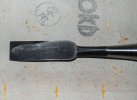- Joined
- Feb 11, 2016
- Messages
- 2,541
Over the past few months, in the context of spoon carving and sloyd knives, I've become aware of a style of sharpening scandi-ground knives called a "flat over hollow" grind. It is created by first using a wheel to hollow-grind the bevel and then using flat stones to establish small flats at the shoulder and apex. The idea is that the flats yield the same carving performance as a true flat grind while the hollow allows for quicker resharpening with flat stones because there is less material to remove. It's also supposed to be less prone to convexing the edge while resharpening. Once the hollow has been ground away by many resharpenings, it's back to the wheel to establish a new hollow.
Here's an example I inexpertly put on my Marttiini Lynx Lumberjack, leaving the scratch marks in the hollow since they shouldn't matter for performance:

It's not a great photo, and the flats are new and quite small, but I hope it gives the idea. This knife sees a lot of hard use working outside in the garden and I like the idea of being able to quickly sharpen it with flat stones before putting it back to work. I'm looking forward to seeing how well it works in practice.
It's new to me, but it's such a practical technique for enabling quick and accurate field sharpening that I have to suspect that it's been in use on hard-working scandi-ground knives for a very long time. I'm curious whether history backs up that suspicion and that's why I'm asking here in the traditional forum. Does anyone know whether this is a long established technique for scandi-ground knives like puukkos and sloyds? Are old scandi-ground knives found with this type of grind? Also, is there a more common term for this than "flat over hollow"?
Thanks for reading and I look forward to any insights and discussion that follow.
Here's an example I inexpertly put on my Marttiini Lynx Lumberjack, leaving the scratch marks in the hollow since they shouldn't matter for performance:

It's not a great photo, and the flats are new and quite small, but I hope it gives the idea. This knife sees a lot of hard use working outside in the garden and I like the idea of being able to quickly sharpen it with flat stones before putting it back to work. I'm looking forward to seeing how well it works in practice.
It's new to me, but it's such a practical technique for enabling quick and accurate field sharpening that I have to suspect that it's been in use on hard-working scandi-ground knives for a very long time. I'm curious whether history backs up that suspicion and that's why I'm asking here in the traditional forum. Does anyone know whether this is a long established technique for scandi-ground knives like puukkos and sloyds? Are old scandi-ground knives found with this type of grind? Also, is there a more common term for this than "flat over hollow"?
Thanks for reading and I look forward to any insights and discussion that follow.
Last edited:







